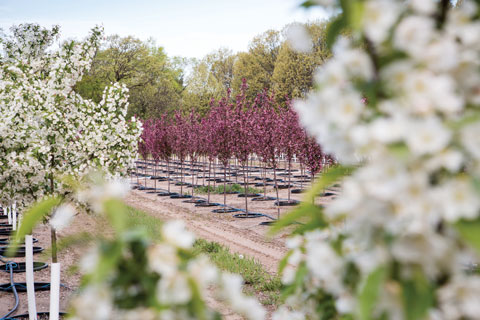4/1/2018
Meeting Demand: Forecasting to Meet Increasing Shade Tree Demand
Alec Charais

A great deal has been written the last few years regarding the shortage of caliper shade trees in the marketplace since the economic downturn between 2008-2012, and rightfully so. Many nursery wholesalers, landscapers and retailers have been left scrambling to find supply of material in a new market with fewer growers fulfilling larger trees.
For many, the risks—namely large capital investments in land and labor—outweigh long-waited return on investment. With demand continuing to outpace supply, what we learned from the Great Recession has played a large role in how growers such as Bailey Nurseries plan their production to try and meet demand, while also mitigating the risks involved with these long-term crops.
It was a perfect storm that led to the shortfalls we see today. As mentioned, due to the nature of growing, tying up large amounts of land in trees that are subject to Mother Nature (wind, floods, hail, disease, etc.) are assumed risks in and of themselves. With current labor shortages as they are today, growers not only need to invest more in training and retaining their people, but it also contributes to how they must manage their inventories. If one hard lesson was learned, it was that it was better to be sold out than to grow surplus.
What we at Bailey Nurseries learned, in addition to working harder to efficiently produce trees at the bareroot liner stage, was twofold. First, forecasting anticipated demand is something we’ve always placed a high priority on. If we know one thing about the tree market, the constant is that it will ebb and flow and there will be periods where tree demand will be high and years when it won’t. Maintaining consistent supply and not overreacting to market changes is something growers have to weigh out annually.
Second, minimizing risks by planting at the young liner stage and stretching programs from propagation to one- and two-year fields allows for market reaction to a point. We all know that trees don’t grow overnight, but leveraging multiple options at the propagation and seedbed stage allows us to catch up where we can. Planting stock where it grows best in Oregon and Minnesota also plays a large role in assisting with meeting demand.
The container shrub growers who have rebounded through the downturn and are seeing growth are the ones who are effectively managing their inventories. Caliper tree growers are no different. Years ago, it was common to see mid- to large-sized growers plant hundreds if not thousands of a single variety. Today, diversity in production planning mirrors the same need to diversify the urban forest. Meaning, if you aren’t familiar with some of the new trees out there, go visit your local nursery and get acquainted with what they produce and their quality. Build the relationship where both of you can gain from the partnership.
By all accounts, 2018 looks to be a strong year for our industry. Due to a strong dollar, inflation rates are predicted to be around 1.9% this year without much change for the next two or three years. The housing market continues to recover and will for the foreseeable future. All of this points towards increased demand for shade and ornamental trees.
In the years to come, based on what we learned since 2012, growers planting today rely on communication from the end-users of their products. Placing orders early is great and definitely helps, but having flexibility in the stock used is critical. Educate your retail customers and staff on varieties that are relied upon and work with your contract growers on preferred selections for your area. There are a lot of great varieties out there that are underused—believe it or not, there are maples to select besides Autumn Blaze! GT
Alec Charais is Marketing & Communications Manager for Bailey Nurseries.